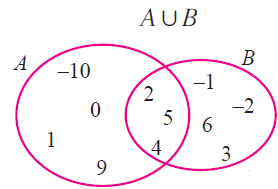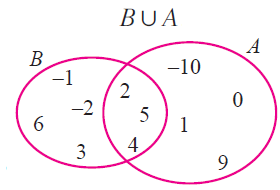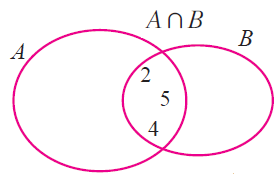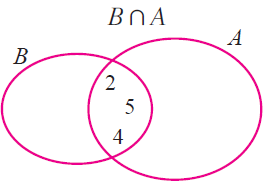COMMUTATIVE PROPERTY OF SET
For any two two sets, the following statements are true.
(i) Set union is commutative
A u B = B u A
(i) Set intersection is commutative
A n B = B n A
If A × B and B × A have same number of elements then A × B ≠ B × A unless and until A = B . Therefore the Cartesian product of two sets is commutative if the two sets are equal.
Example 1 :
A = {-10, 0, 1, 9, 2, 4, 5} and B = {- 1,- 2, 5, 6, 2, 3, 4}, for the sets A and B, verify that
(i) Set union is commutative. Also verify it by using Venn diagram.
(ii) Set intersection is commutative. Also verify it by using Venn diagram.
Solution :
Commutative property :
(i) A u B = B u A
(ii) A n B = B n A
(i) A = {-10, 0, 1, 9, 2, 4, 5} and B = {- 1, -2, 5, 6, 2, 3, 4}
A u B = {-10, 0, 1, 9, 2, 4, 5} u {-1,-2, 5, 6, 2, 3, 4}
= {-10, -2, -1, 0, 1, 2, 3, 4, 5, 6, 9} ----(1)
B u A = {-1, -2, 5, 6, 2, 3, 4} u {-10, 0, 1, 9, 2, 4, 5}
= {-10, -2, -1, 0, 1, 2, 3, 4, 5, 6, 9} ----(2)
(1) = (2)
Verifying in Venn diagram :


(ii) A = {-10, 0, 1, 9, 2, 4, 5} and B = {-1,-2, 5, 6, 2, 3, 4}
A n B = {-10, 0, 1, 9, 2, 4, 5} n {-1,-2, 5, 6, 2, 3, 4}
= { 2, 4, 5 } ----(3)
B n A = {-1,-2, 5, 6, 2, 3, 4} n {-10, 0, 1, 9, 2, 4, 5}
= { 2, 4, 5 } ----(4)
(3) = (4)
Verifying in Venn diagram :


Example 2 :
A = {1, 2, 3, 4, 5} and B = {3, 4, 5, 6}, for the sets A and B, verify that
(i) set union is commutative.
(ii) set intersection is commutative.
Solution :
Commutative property :
(i) A u B = B u A
(ii) A n B = B n A
(i) A = {1, 2, 3, 4, 5} and B = {3, 4, 5, 6}
A u B = {1, 2, 3, 4, 5} u {3, 4, 5, 6}
= {1, 2, 3, 4, 5, 6} ----(5)
B u A = {3, 4, 5, 6} u {1, 2, 3, 4, 5}
= {1, 2, 3, 4, 5, 6} ----(6)
(5) = (6)
(i) A = {1, 2, 3, 4, 5} and B = {3, 4, 5, 6}
A n B = {1, 2, 3, 4, 5} n {3, 4, 5, 6}
= {3, 4, 5} ----(7)
B n A = {3, 4, 5, 6} U {1, 2, 3, 4, 5}
= {3, 4, 5} ----(8)
(7) = (8)
Example 3 :
In a class of 50 students, 35 opted for Mathematics and 37 opted for Commerce. The number of such students who opted for both Mathematics and Commerce are
a) 13 b) 15 c) 22 d) 28
Solution :
Total number of students = 50
Let A and B be number of students who opted for Math and Commerce respectively.
Number of students opted for Mathematics = 35
Number of students opted for Commerce = 37
Let A n B be the number of students who opted for Math and Commerce.
n(A U B) = n(A) + n(B) - n(A n B)
50 = 35 + 37 - n(A n B)
n(A n B) = 35 + 37 - 50
= 72 - 50
= 22
So, number of students who opted for both Math and Commerce is 22.
Example 4 :
In a class of 80 students, 35% students can play cricket, 45% students can pay only tennis and the remaining students can play both games. In all how many students can lay cricket ?
a) 55 b) 44 c) 36 d) 28
Solution :
Total number of students in the class = 80
Let A and B be the number of students play cricket and tennis.
n(A n B bar) = 35% ==> 0.35(80) ==> 28
n(B n A bar) = 45% ==> 0.45 (80) ==> 36
n(A U B) = 80
Let n(A n B) = x
n(A n B bar) = n(A) - n(AnB)
28 = n(A) - x
n(A) = 28 + x
n(B n A bar) = n(B) - n(AnB)
36 = n(B) - x
n(B) = 36 + x
n(AUB) = n(A) + n(B) - n(AnB)
28 + x + 36 + x - x = 80
64 + x = 80
x = 80 - 64
x = 16
So, the number of students who play cricket is 16.
Example 5 :
If Set A is any set subset of an Universal Set U then A ∩ U = A
Solution :
For example,
If Set U = {1, 2, 3, 4, 5, 6, 7} and Set A = {1, 2, 3, 4}
then A ∩ U = {1, 2, 3 ,4, 5, 6, 7} ∩ {1, 2, 3, 4}
= {1, 2, 3, 4}
= A
Kindly mail your feedback to v4formath@gmail.com
We always appreciate your feedback.
©All rights reserved. onlinemath4all.com
Recent Articles
-
Digital SAT Math Problems and Solutions (Part - 150)
Apr 25, 25 11:46 AM
Digital SAT Math Problems and Solutions (Part - 150) -
AP Calculus AB Problems with Solutions (Part - 19)
Apr 24, 25 11:10 PM
AP Calculus AB Problems with Solutions (Part - 19) -
AP Calculus AB Problems with Solutions (Part - 18)
Apr 24, 25 11:06 PM
AP Calculus AB Problems with Solutions (Part - 18)
